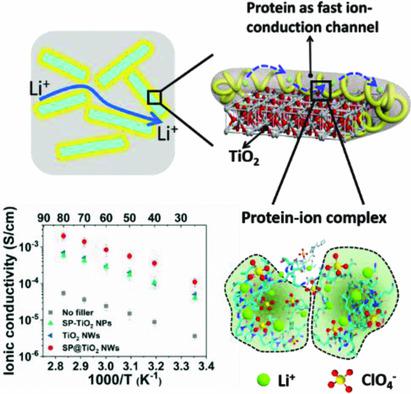Our official English website, www.x-mol.net, welcomes your feedback! (Note: you will need to create a separate account there.)
Core–Shell Hybrid Nanowires with Protein Enabling Fast Ion Conduction for High‐Performance Composite Polymer Electrolytes
Small ( IF 13.3 ) Pub Date : 2018-10-17 , DOI: 10.1002/smll.201803564 Xuewei Fu 1 , Yu Wang 1 , Xin Fan 2 , Louis Scudiero 3 , Wei-Hong Zhong 1
Small ( IF 13.3 ) Pub Date : 2018-10-17 , DOI: 10.1002/smll.201803564 Xuewei Fu 1 , Yu Wang 1 , Xin Fan 2 , Louis Scudiero 3 , Wei-Hong Zhong 1
Affiliation

|
Incorporating nanofillers is one of the promising approaches for simultaneously boosting the ionic conductivity and mechanical properties of solid polymer electrolytes (SPEs). However, effectively creating faster ion‐conduction pathways via nanofillers still remains a big challenge. Herein, core–shell protein–ceramic nanowires for more efficiently building fast ion‐conduction networks in SPEs are reported. The core–shell protein–ceramic nanowires are fabricated via in situ growth of protein coating on the electrospun TiO2 nanowires in a subtly controlled protein‐denaturation process. It is demonstrated that the core–shell protein@TiO2 nanowires effectively facilitate ion‐conduction. As a result, the ionic conductivity, mechanical properties, electrochemical stability, and even Li+ transference number of the SPEs with core–shell protein@TiO2 nanowires are significantly enhanced. The contributions from the 1D morphology of the protein@TiO2 nanowires, and more importantly, the favorable protein structure for further promoting ion‐conduction at the polymer–filler interfaces are analyzed. It is believed that the protein plays a pivotal role in dissociating lithium salts, which benefits from the strong interactions between protein and ions, making the protein serve as a unique “natural channel” for rapidly conducting Li+. This study initiates an effective method of promoting ionic conductivity and constructing faster ion‐conduction networks in SPEs via combining bio‐ and nanotechnology.
中文翻译:

核壳混合纳米线,具有蛋白质,可实现快速离子导电,可用于高性能复合聚合物电解质
掺入纳米填料是同时提高固体聚合物电解质(SPE)的离子电导率和机械性能的有前途的方法之一。然而,通过纳米填料有效地创建更快的离子传导途径仍然是一个巨大的挑战。在此,据报道,用于在SPE中更有效地建立快速离子传导网络的核-壳蛋白-陶瓷纳米线。核-壳蛋白-陶瓷纳米线是通过在微控制的蛋白变性过程中在电纺TiO 2纳米线上原位生长蛋白涂层而制成的。结果表明,核-壳蛋白@TiO 2纳米线有效地促进了离子传导。结果,离子电导率,机械性能,电化学稳定性,甚至锂具有核-壳蛋白@TiO 2纳米线的SPE的+转移数显着增加。分析了蛋白质@TiO 2纳米线的一维形态的贡献,更重要的是,分析了有利于进一步促进聚合物-填料界面离子传导的蛋白质结构。人们认为,蛋白质在离解锂盐中起关键作用,这得益于蛋白质与离子之间的强相互作用,使蛋白质成为快速传导Li +的独特“天然通道” 。这项研究通过结合生物技术和纳米技术,开创了一种有效的方法来提高SPE中的离子电导率并构建更快的离子传导网络。
更新日期:2018-10-17
中文翻译:

核壳混合纳米线,具有蛋白质,可实现快速离子导电,可用于高性能复合聚合物电解质
掺入纳米填料是同时提高固体聚合物电解质(SPE)的离子电导率和机械性能的有前途的方法之一。然而,通过纳米填料有效地创建更快的离子传导途径仍然是一个巨大的挑战。在此,据报道,用于在SPE中更有效地建立快速离子传导网络的核-壳蛋白-陶瓷纳米线。核-壳蛋白-陶瓷纳米线是通过在微控制的蛋白变性过程中在电纺TiO 2纳米线上原位生长蛋白涂层而制成的。结果表明,核-壳蛋白@TiO 2纳米线有效地促进了离子传导。结果,离子电导率,机械性能,电化学稳定性,甚至锂具有核-壳蛋白@TiO 2纳米线的SPE的+转移数显着增加。分析了蛋白质@TiO 2纳米线的一维形态的贡献,更重要的是,分析了有利于进一步促进聚合物-填料界面离子传导的蛋白质结构。人们认为,蛋白质在离解锂盐中起关键作用,这得益于蛋白质与离子之间的强相互作用,使蛋白质成为快速传导Li +的独特“天然通道” 。这项研究通过结合生物技术和纳米技术,开创了一种有效的方法来提高SPE中的离子电导率并构建更快的离子传导网络。



























 京公网安备 11010802027423号
京公网安备 11010802027423号